Sustainable Strategies towards Restoring Soil Health and Fertility
A special issue of International Journal of Environmental Research and Public Health (ISSN 1660-4601). This special issue belongs to the section "Environmental Earth Science and Medical Geology".
Deadline for manuscript submissions: closed (22 March 2023) | Viewed by 7405
Special Issue Editors
Interests: climate and environment; carbon sequestration; soil quality; soil organic matter; soil amendments; biochar; analytical and applied pyrolysis
Special Issues, Collections and Topics in MDPI journals
Interests: biochar; heavy metals; soil pollution; remediation; soil amendment; pyrolysis
Special Issues, Collections and Topics in MDPI journals
Special Issue Information
Dear Colleagues,
Life on Earth depends on healthy soils that provide food, clean water, habitats for biodiversity and other important ecosystem services. Nevertheless, poor agricultural management, pollution due to atmospheric deposition and mining activities, irresponsible application of high loads of fertilizers and pesticides, and the deposition of residues can alter the ecological balance of soils in the short and long term. Their consequences encompass the loss of soil productive capacity and environmental problems that are directly (eutrophication, erosion, etc.) and indirectly (greenhouse effect, loss of biodiversity, etc.) related to soils. Thus, soils are globally a threatened resource. Restoring soil's productive capacity and avoiding risks for environment health must be performed in a sustainable way.
The circular economy represents a promising model for supporting sustainable agriculture and reducing the environmental impact of production, processing, and waste-management-related activities. Thus, nutrients present in organic waste can potentially be utilized as fertilizers or soil amendments to reduce the economic and environmental costs associated with fertilizer production and waste disposal. On the other hand, transformed organic wastes are also being used to reclaim degraded soils, as their application supports pollutant stabilization and a greater contribution of carbon to soil, which increases soil’s water retention capacity and, consequently, its physical, chemical, and biological quality.
Therefore, this Special Issue focuses on promoting sustainable agriculture and strategies for the restoration of degraded soils, with special emphasis on soil health effects, covering biological, chemical, physical, biochemical, and environmental aspects.
Dr. José De la Rosa
Dr. Paloma Campos
Guest Editors
Manuscript Submission Information
Manuscripts should be submitted online at www.mdpi.com by registering and logging in to this website. Once you are registered, click here to go to the submission form. Manuscripts can be submitted until the deadline. All submissions that pass pre-check are peer-reviewed. Accepted papers will be published continuously in the journal (as soon as accepted) and will be listed together on the special issue website. Research articles, review articles as well as short communications are invited. For planned papers, a title and short abstract (about 250 words) can be sent to the Editorial Office for assessment.
Submitted manuscripts should not have been published previously, nor be under consideration for publication elsewhere (except conference proceedings papers). All manuscripts are thoroughly refereed through a single-blind peer-review process. A guide for authors and other relevant information for submission of manuscripts is available on the Instructions for Authors page. International Journal of Environmental Research and Public Health is an international peer-reviewed open access monthly journal published by MDPI.
Please visit the Instructions for Authors page before submitting a manuscript. The Article Processing Charge (APC) for publication in this open access journal is 2500 CHF (Swiss Francs). Submitted papers should be well formatted and use good English. Authors may use MDPI's English editing service prior to publication or during author revisions.
Keywords
- organic amendments
- organic fertilizer
- sustainability
- soil remediation
- soil organic matter
- waste as soil ameliorant
- biochar
- compost
- pollutants
- heavy metals
Benefits of Publishing in a Special Issue
- Ease of navigation: Grouping papers by topic helps scholars navigate broad scope journals more efficiently.
- Greater discoverability: Special Issues support the reach and impact of scientific research. Articles in Special Issues are more discoverable and cited more frequently.
- Expansion of research network: Special Issues facilitate connections among authors, fostering scientific collaborations.
- External promotion: Articles in Special Issues are often promoted through the journal's social media, increasing their visibility.
- Reprint: MDPI Books provides the opportunity to republish successful Special Issues in book format, both online and in print.
Further information on MDPI's Special Issue policies can be found here.






